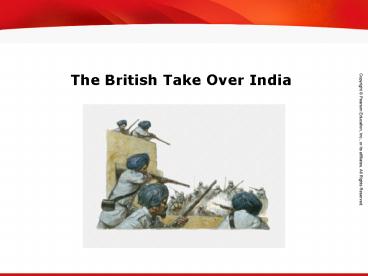The British Take Over India - PowerPoint PPT Presentation
1 / 19
Title: The British Take Over India
1
The British Take Over India
2
Objectives
- Understand the causes and effects of the Sepoy
Rebellion. - Explain how British rule affected India.
- Describe how Indians viewed Western culture.
- Identify the origins of Indian nationalism.
3
Terms and People
- sati Hindu custom that called for a widow to
join her husband in death by throwing herself on
his funeral fire - sepoy Indian soldier hired by the British East
India Company sepoys rebelled in 1857 - viceroy British official who ruled in India in
the name of the queen - deforestation the destruction of forest land
4
Terms and People (continued)
- Ram Mohun Roy Indian reformer who founded Hindu
University in Calcutta sought to reform but not
replace Indian culture - purdah the isolation of women into separate
quarters
5
How did Britain gradually extend its control over
most of India, despite opposition?
For more than 200 years, Mughal rulers governed a
powerful empire in India. By the mid-1700s,
however, the Mughal empire was collapsing from a
lack of strong rulers. Britain then turned its
commercial interests in southern Asia into
political interests and gained control of India.
6
- In the 1600s the British East India Company won
trading rights on the fringe of the Mughal
empire. - As the Mughal empire declined, the British gained
control. - By the mid-1800s the company controlled about
three fifths of India.
The Mughal Empire
7
India was a land of great diversity. Britain
exploited that diversity to gain control.
India was home to many cultures and peoples. When
the Mughal empire began to crumble, these groups
could not unite to expel outsiders.
Britain took advantage of this disunity by
encouraging competition between rival princes.
8
- The British improved roads, reduced banditry, and
introduced Western education and legal
procedures. - They pushed for social changes such as ending
slavery and the caste system. - British officials banned sati, a custom in which
a wife was expected to kill herself on her
husbands funeral fire.
Although the East India Companys goal was to
make money, British policies aimed to improve
India as well.
9
British insensitivity to local customs led to the
bloody Sepoy Rebellion in 1857.
- The sepoys were Indian soldiers hired to fight
for the British. - The British issued a number of rules that angered
the sepoys and finally provoked them to rebel.
10
Sepoys were ordered to serve overseas. For high-caste Hindus, such travel was forbidden.
Company rules allowed Hindu widows to remarry. The sepoys objected to this as a violation of Hindu practice.
New rifles were issued in 1857. To load the rifle one had to bite off the end of a bullet cartridge. The cartridges were greased with cow or pig fat. Cows were sacred animals to Hindus, and pigs were forbidden to Muslims.
11
(No Transcript)
12
After the Sepoy Rebellion, Britain took control
of India from the East India Company.
- Parliament placed India directly under the
British crown. - Britain sent troops to India and taxed Indians to
pay for them. - Indians were angered at how Britain extracted
great wealth from India.
13
Parliament set up a system of colonial rule
called the British Raj.
- A British viceroy ruled in the queens name.
- High officials were British, but Indians held
lower posts. - With some local cooperation, India became the
crown jewel of the British Empire.
14
British rule brought some benefits to India.
Britain revised the legal system. They promoted equality and justice regardless of caste. There was more peace and order.
Britain built rail and telegraph lines. Indians could travel and communicate more easily. Indians began to unite.
Upper-class Indians benefited the most. The upper classes benefited from a British education. Indian princes and landowners grew wealthy from trade.
15
Britain felt they were helping India to
modernize. However, their policies mostly
benefited the British.
16
Indians were divided in their attitudes toward
modernization and Britain.
Upper-class and educated Indians adopted more
modern ways.
17
Ram Mohun Roy tried to combine the old and the
new in the early 1800s.
18
The British were also divided in their attitudes
toward Indian culture.
As Indian classics were translated, many
Englishmen gained respect for Indian literature
and religious ideas.
19
British leaders provided promising young Indians
with a British education, thinking this would
lead them to accept British culture and rule.
- The Indian National Congress formed in 1885 to
propose self-rule within the British Empire. - Muslims feared that Hindus might dominate any
government. In 1906, they founded the Muslim
League and soon began talking about a separate
Muslim state.
Instead, educated Indians returned home and began
nationalistic movements.































